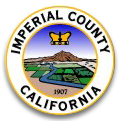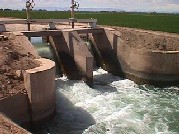
Irrigation Management and Water Quality

Objectives: Design, implement, and evaluate educational and applied research programs in irrigation, water management, soil salinity, water quality, and Total Maximum Daily Load (TMDL) standards related to irrigated agriculture.
Situation Statement: Approximately 3.0 million acre-feet of Colorado River water are used every year to irrigate more than 450,000 acres of lands in the Imperial Valley. Surface and subsurface drainage water from irrigated fields enters the Salton Sea which serves as a drainage sink for the Imperial and Coachella Valleys since its formation in 1905. Currently, the salinity of the Sea is over 46,000 ppm or approximately 135% the salinity of the Pacific Ocean. More than 17% of the delivered irrigation water in the Imperial Valley becomes tailwater runoff. This water transports significant amount of chemicals that eventually reach the Salton Sea. Efficient irrigation management practices are needed to improve irrigation efficiency, and to comply with the new sediment/silt and nutrient TMDL standards. Water transfer, Salton Sea, and Total Maximum Daily Load (TMDL) concerns are the issues of major importance to growers and the people of the Imperial Valley.
The current water transfer agreement between Imperial Irrigation District (IID) and the San Diego County Water Authority (SDCWA) calls for transfer of up to 200,000 acre-feet annually of Imperial Valley-Colorado River water to San Diego. Most of the water available for transfer will have to come from on-farm water conservation programs. Our research and educational programs are directed toward the development and demonstration of new methods to conserve water and minimize surface runoff.
Our current work is focused on field and vegetable crops, specifically alfalfa, sudangrass, wheat, lettuce, broccoli, corn, and watermelons. In 2006, field crops accounted for almost 80% of the 500,000 acres of irrigated land in the Imperial Valley. Alfalfa water use accounts for approximately 35% of the total crop water use in the Imperial Valley. Our educational and applied research activities were geared directly to deal with the current problems discussed above as well as with the expected problems in the future (Salton Sea Nutrient TMDL). The main objective of my educational activities is to extend the knowledge of new irrigation and soil management practices to prevent salinity buildup, improve water use efficiency, and improve water quality in Imperial Valley.
For additional information, contact Ali Montazar.
